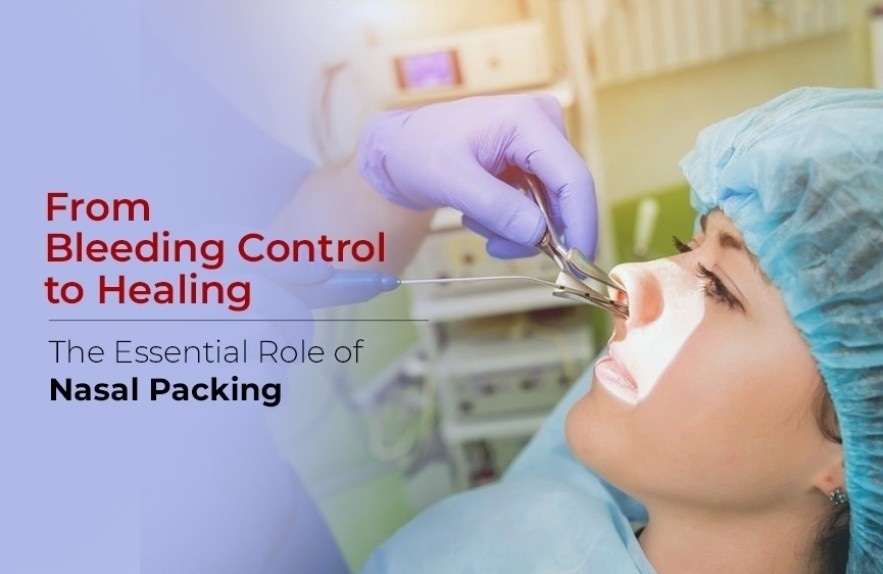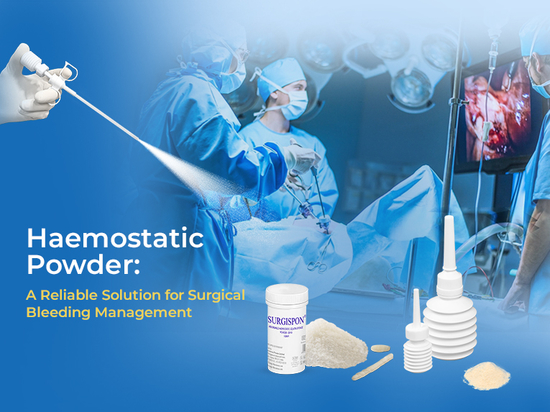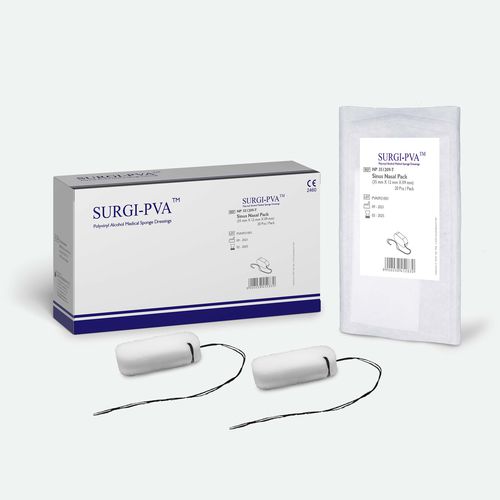
#Product Trends
From bleeding control to healing: the essential role of nasal packing
SURGISPON® NASAL/DERMAL CARE
Recovering from nasal surgeries can be challenging for patients, often marked by discomfort and concerns about potential complications. Nasal packing plays a vital role in ensuring a smoother recovery, addressing challenges like bleeding, pain, and tissue healing. Whether it’s a common procedure like septoplasty or a more complex sinus surgery (a procedure to remove blockages and improve drainage), the right nasal packing material can significantly impact the patient’s comfort and overall healing process.
Nasal obstruction is a common concern in Ear, Nose, and Throat (ENT) care, often leading to procedures like septoplasty, conchotomy (surgical removal of nasal concha or turbinates to improve airflow), endoscopic sinus surgery, and rhinoseptoplasty (a combined surgery to correct nasal structure and septum deviation for functional or cosmetic reasons) to restore normal breathing. Septoplasty is one of the most frequently performed surgeries in otolaryngology and is aimed at correcting a deviated nasal septum. This procedure addresses symptoms such as nasal obstruction, mouth breathing, snoring, recurrent sinusitis, and even chronic nosebleeds. Patients may also seek septoplasty to correct structural issues, like septal spurs (bony or cartilaginous projections along the nasal septum that obstruct airflow), that contribute to chronic symptoms. In most patients with impaired nasal breathing, the most common originating factors leading to pronounced manifestation are septal deviation (76% of cases), nasal turbinate hypertrophy (enlargement of the turbinates inside the nose responsible for humidifying and filtering air- in 72% of cases), and collapsed external nasal valve (67% of cases), as well as other anatomical prerequisites such as septal spurs [1].
Nasal packing is an essential postoperative tool in managing complications and aiding recovery after nasal surgeries. From controlling bleeding to promoting optimal healing, the choice of nasal packing material can significantly influence patient outcomes. This blog delves into the purpose of nasal packing, the types available, and the clinical evidence supporting its use in various surgical scenarios.
Why Nasal Packing?
Nasal packing is often used to manage specific postoperative challenges and help patients recover smoothly. Key roles of nasal packing include:
● Hemostasis: Packing helps control bleeding by applying pressure to blood vessels, minimizing hemorrhage. By facilitating clot formation at the site of bleeding, it creates a stable environment for healing to begin.
● Preventing Hematomas: Packing prevents the accumulation of blood between tissue layers, mitigating the risk of hematoma formation (localized blood collection outside vessels) and subsequent complications.
● Stabilizing Nasal Cartilage: Packing maintains the position of cartilage after reconstruction, reducing the likelihood of deformities.
● Healing Environment: Packing can provide a moist healing environment, which is essential for reducing tissue irritation, encouraging epithelial growth, and improving overall outcomes [2].
Types of Nasal Packing
Nasal packs are categorized based on three criteria: their material composition, resorbability, whether they are absorbable or non-absorbable, and their application sites within the nasal passages. Here’s a look at some common types and their unique characteristics:
1. Absorbable Packs: These are made from materials that the body gradually absorbs, such as hyaluronic acid (e.g., MeroGel) or polyurethane foam (e.g., Nasopore). These packs offer the benefit of eliminating the need for removal, enhancing patient comfort. However, they generally provide lower compression, which may limit their effectiveness in controlling heavy bleeding [3]. In situations where stronger hemostasis is required, non-absorbable options may be more suitable.
For example, gelatin sponge-based products like SURGISPON® Nasal Pack (strip/tampon) or similar alternatives are often used to manage mild to moderate nosebleeds. Their microporous structure activates coagulation, effectively absorbing blood and exudates while forming a protective gel that reduces pain during bandage changes. This type of packing is well-suited for traumatic or chronic nasal bleeds, especially in patients with allergies or those recovering from surgery. SURGISPON® nasal products are available in various forms, including SURGISPON® Nasal Strip (80×15×17), SURGISPON® Strip (40×10×10), and SURGISPON® Nasal Tampon (80×07).
Alternatives such as Gelfoam and Cutanplast are also widely used for surgical packing and offer similar hemostatic properties [4]. The choice of product often depends on several factors, including the required hemostatic strength, absorbability, and cost-effectiveness, allowing clinicians to select the most appropriate option for each patient’s needs.
2. Non-Absorbable Packs: Non-absorbable packs provide stronger compression, making them suitable for cases involving significant bleeding. These packs must be removed once bleeding is under control. The most commonly used types include:
• Polyvinyl Alcohol (PVA) Tamponades: PVA packs, like Merocel, expand when they absorb fluids, increasing pressure on blood vessels and improving bleeding control [5]. SURGI-PVA™ is another PVA-based pack with hydrophilic, absorbent properties, designed to retain moisture while providing patient comfort. Its Ultraclean PVA technology offers a lint-, fiber-, and latex-free design that minimizes irritation and infection risk. The 3D open-cell structure ensures strength and flexibility, allowing for gentle, atraumatic removal.
● Balloon Tamponades: Balloon-based packs, like Rapid Rhino (a nasal device designed for effective nosebleed management), are inflatable devices that provide targeted compression to specific bleeding sites. This adjustability makes them a flexible and effective option for bleeding control, offering the advantage of reducing tissue stress and minimizing damage. Balloon tamponades are particularly useful for addressing localized bleeding areas and are generally more comfortable for the patient during use. [6]. Further research has shown that balloon tamponades can significantly reduce postoperative bleeding and may be especially beneficial in high-risk cases, such as patients with coagulation disorders. For example, a study published in the Journal of Clinical Medicine found that intrauterine balloon tamponade was successful in controlling bleeding in most of the cases, including those with coagulation disorders, demonstrating its effectiveness in high-risk scenarios [7].
● Splints: Nasal splints, typically made from materials like plastic or silicone, are positioned on both sides of the septum to prevent tissue contact and stabilize the nasal structure after surgery. However, splints can be more costly than simpler options like intranasal gauze [8]. Research has shown that both transseptal suturing (stitching the nasal septum to maintain its position) and intranasal splints (devices inserted inside the nasal cavity to prevent tissue adhesion and support structure) are effective in managing postoperative complications, including synechiae formation (scar tissue formation between nasal surfaces), following septoplasty. Splints remain a viable option for stabilizing nasal structures while maintaining airflow, contributing to patient comfort and healing [9].
Each of these non-absorbable options provides unique benefits in controlling bleeding, stabilizing the nasal structure, and enhancing patient comfort during recovery. The selection of a specific option depends on the clinical scenario and patient needs.
Clinical Evidence Supporting Nasal Packing
A meta-analysis compared absorbable nasal packs (such as Cutanplast, Merogel, CMC Foam, Nasopore, and Spongostan) to non-absorbable options like Merocel (polyvinyl alcohol packs) and PVA sponges after functional endoscopic sinus surgery (FESS) for the treatment of chronic rhinosinusitis (inflammation of the nasal passages and sinuses) [10]. Results suggest that absorbable materials generally perform better, showing lower rates of synechia (scar tissue formation) and reduced postoperative bleeding. These findings indicate that the choice of nasal packing material may significantly affect bleeding control, patient comfort, and overall recovery [11].
Key Findings
● Synechia Prevention: Absorbable packs have been associated with lower synechia rates (4.6–8%) compared to non-absorbable packs (8–35.7%).
● Bleeding and Pain: Absorbable packs tend to reduce postoperative bleeding and are associated with less pain, especially during removal.
● Patient Comfort: Studies report greater patient comfort with absorbable packing due to the need for less frequent removal and lower pain scores.
Conclusion
Nasal packing materials play an important role in supporting recovery following ESS and other nasal surgeries. While both absorbable and non-absorbable materials have their advantages, absorbable options generally lead to better outcomes in terms of bleeding control, synechia prevention, and patient comfort. The choice of nasal packing should be guided by the specific needs of the patient, the type of surgery, and the potential for postoperative complications. As more studies emerge, they continue to inform best practices, allowing patients to benefit from innovations in nasal packing technology and postoperative care.
References:-
[1] Gamerra M, Cantone E, Sorrentino G, De Luca R, Russo MB, De Corso E, Bossa F, De Vivo A, Iengo M. Mathematical model for preoperative identification of obstructed nasal subsites. Acta Otorhinolaryngologica Italica. 2017 Oct;37(5):410.
[2] Ivanova PP, Iliev G. Nasal packing in septal surgery: a narrative review. Cureus. 2023 Mar;15(3).
[3] Wang J, Cai C, Wang S. Merocel versus Nasopore for nasal packing: a meta-analysis of randomized controlled trials. PLoS One. 2014 Apr 7;9(4):e93959.
[4] Paternò VA, Bisin A, Addis A. Comparison of the efficacy of five standard topical hemostats: a study in porcine liver and spleen models of surgical bleeding. BMC surgery. 2020 Dec;20:1-0.
[5] Pringle MB, Beasley P, Brightwell AP. The use of Merocel nasal packs in the treatment of epistaxis. The Journal of Laryngology & Otology. 1996 Jun;110(6):543-6.
[6] Pradhan P, Preetam C, Parida PK. Efficacy of Balloon Tamponade Versus Merocel Nasal Packs in Endoscopic Sinonasal Surgery: A Randomized Controlled Study. Indian Journal of Otolaryngology and Head & Neck Surgery. 2022 Oct;74(Suppl 2):1113-9.
[7] Futcher F, Moufawad G, Centini G, Hayek J, Tarchichi J, Bakar J, Habib N. Intrauterine Tamponade Balloon for Management of Severe Postpartum Haemorrhage: Does Early Insertion Change the Outcome? A Retrospective Study on Blood Loss. Journal of Clinical Medicine. 2023 Aug 22;12(17):5439.
[8] Iqbal IZ, Jones GH, Dawe N, Mamais C, Smith ME, Williams RJ, Kuhn I, Carrie S. Intranasal packs and haemostatic agents for the management of adult epistaxis: systematic review. The Journal of Laryngology & Otology. 2017 Dec;131(12):1065-92.
[9] Aldhwaihy L, Alhazzani H, Alkarzae M. Comparison on the Effectiveness and Safety of Transseptal Suturing Versus Intranasal Splints After Septoplasty: A Systematic Review and Meta-analysis. Aesthetic Plastic Surgery. 2024 May 20:1-0.
[10] Cho KS, Park CH, Hong SL, Kim MJ, Kim JY, Kim YW, Koo SK, Roh HJ. Comparative analysis of Cutanplast and Spongostan nasal packing after endoscopic sinus surgery: a prospective, randomized, multicenter study. European Archives of Oto-Rhino-Laryngology. 2015 Jul;272:1699-705.
[11] Wang TC, Tai CJ, Tsou YA, Tsai LT, Li YF, Tsai MH. Absorbable and nonabsorbable packing after functional endoscopic sinus surgery: Systematic review and meta-analysis of outcomes. European Archives of Oto-Rhino-Laryngology. 2015 Aug;272:1825-31.






